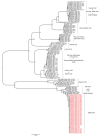Update on the Phylodynamics of SADS-CoV
- PMID: 34440564
- PMCID: PMC8402179
- DOI: 10.3390/life11080820
Update on the Phylodynamics of SADS-CoV
Abstract
Coronaviruses are known to be harmful and heterogeneous viruses, able to infect a large number of hosts. Among them, SADS-CoV (Swine Acute Diarrhea Syndrome Coronavirus), also known as PEAV (Porcine Enteric Alphacoronavirus), or SeA-CoV (Swine Enteric Alphacoronavirus), is the most recent Alphacoronavirus discovered, and caused several outbreaks reported in Chinese swine herds between late 2016 and 2019. We performed an upgraded phylodinamic reconstruction of SADS-CoV based on all whole genomes available on 21 June 2021. Results showed a very close relationship between SADS-CoV and HKU2-like CoV, which may represent the evolutionary intermediate step towards the present SADS-CoV. The direct progenitor of SADS-CoV is so far unknown and, although it is well known that horseshoe bats are reservoirs for Rhinolophus bat coronavirus HKU2-like (HKU2-like CoVs), the transmission path from bats to pigs is still unclear. The discrepancies in the phylogenetic position of rodent CoV, when different molecular markers were considered, corroborate the recombination hypothesis, suggesting that wild rats, which are frequent in farms, may have played a key role. The failure of the attempt at molecular dating, due to the lack of a clock signal, also corroborates the occurrence of a recombination event hypothesis. Zoonotic infections originating in wildlife can easily become a significant threat for human health. In such a context, due to the high recombination and cross-species capabilities of Coronavirus, SADS-CoV represents a possible high-risk pathogen for humans which needs a constant molecular monitoring.
Keywords: Alphacoronavirus; coronavirus; epidemiology; genetic diversity; phylodynamics.
Conflict of interest statement
The authors declare no conflict of interest.
Figures



References
LinkOut - more resources
Full Text Sources

